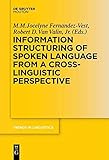Information structuring of spoken language from a cross-linguistic perspective [electronic resource] / edited by M.M. Jocelyne Fernandez-Vest ; Robert D. Van Valin.
Material type: TextSeries: ; 283Publication details: Berlin: : De Gruyter Mouton, 2016.Description: 1 online resourceISBN:
TextSeries: ; 283Publication details: Berlin: : De Gruyter Mouton, 2016.Description: 1 online resourceISBN: - 978-3-11-036875-8
| Item type | Current library | Call number | Status | Date due | Barcode | |
|---|---|---|---|---|---|---|
| E-Resources | Main Library E-Resources | 415 In43 (Browse shelf(Opens below)) | Available | E005199 |
Browsing Main Library shelves, Shelving location: E-Resources Close shelf browser (Hides shelf browser)
Table of contents ; Introduction ; I. Theoretical Approaches to IS ; 1. Detachment Linguistics and Information Grammar of Oral Languages ; 2. Reference and Cognitive Status: Scalar Inference and Typology. 3. Saliency in discourse and sentence form: Zero anaphora and topicalization in Japanese 4. An Overview of Information Structure in three Amazonian Languages ; II. IS and Spoken language ; 5. Micro-variation in information structure: There sentences in Italo-Romance. 6. How does adjacency arise? Grammatical conditions on focus-verb adjacency in Basque 7. Detached NPs with relative clauses in Finnish conversations ; 8. Tag questions and focus markers: Evidence from the Tompo dialect of Even. 9. Syntactic and Prosodic Marking of Contrastiveness in Spoken Chinese 10. Demonstratives and Information Structure in Spoken Estonian ; III. IS and Discourse Particles ; 11. Word order and focus particles in Nakh-Daghestanian languages. 12. The discourse particle to and word ordering in Hindi: From grammar to discourse IV. IS and Language Contacts ; 13. Discourse Regulating Strategies in Pidgin Madam ; 14. New Information Structuring Processes and Morphosyntactic Change ; Name index ; Language index.
The present volume draws together contributions from a number of scholars with an interest in empirical, cross-linguistic description. Most of the papers were first presented at the symposium Information Structure in a Cross-linguistic Perspective held in Oslo in November/December 2000. The descriptions are functionally oriented, and their common focus is how information structure - in a broad sense - can be compared across languages. 'Information structure' has been approached in a variety of ways by the authors, so as to give a broad picture of this fundamental principle of text production, involving the way in which a speaker/writer chooses to present a message in terms of given/new information, focus, cohesion, and point of view. Central to much of the research is the problem of establishing criteria for isolating linguistic constraints on language use from cultural-linguistic conventions in text production. The linguistic comparison includes English, German and/or one of the Scandinavian languages, with sidelights to other languages. Most of the papers are text- or corpus-based, and the ongoing work on parallel corpora in Scandinavia is reflected in several contributions.
There are no comments on this title.






